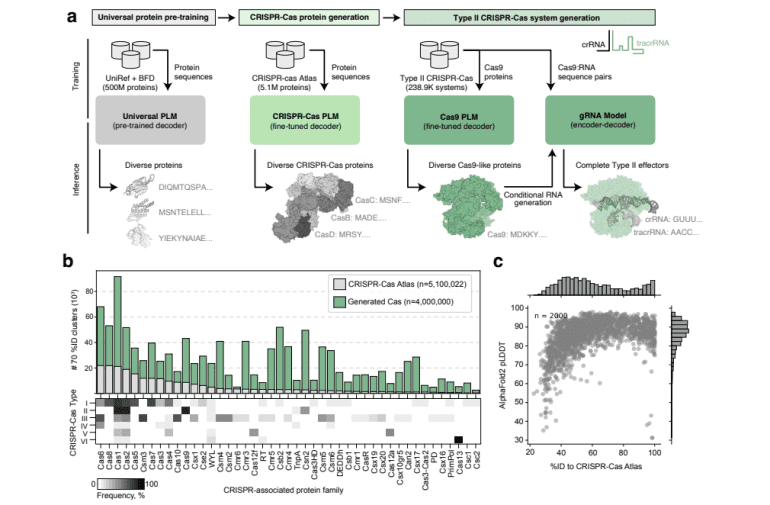- CRISPR-Cas system revolutionizes gene editing, but efficiency and specificity issues persist.
- The research team integrates AI to design novel gene editors, surpassing traditional methods’ limitations.
- OpenCRISPR-1 emerges as a standout, boasting enhanced target accuracy and reduced off-target effects.
- Compatibility with base editing showcases OpenCRISPR-1’s prowess in precise nucleotide modifications.
- AI-generated proteins exhibit remarkable adaptability across varied conditions, which is crucial for human health applications.
Main AI News:
The landscape of gene editing is undergoing a seismic shift, ushering in a new era of possibilities for agriculture, biotechnology, and medicine. At the forefront of this revolution lies the CRISPR-Cas system, originally harnessed from bacterial defense mechanisms. While offering unparalleled precision in genetic manipulation, its transition from microbial realms to complex eukaryotic cells has often been marred by efficiency and specificity challenges.
In response, researchers have tirelessly pursued avenues to bolster the efficacy of CRISPR systems. Conventional methods such as directed evolution and structure-guided design have yielded incremental advancements. Yet, the inherent complexities of protein evolution pose formidable obstacles, leading to suboptimal outcomes outside their native environments.
Enter a visionary research team comprising experts from Profluent Bio, Berkeley, CA, USA; Laboratory of Protein Design and Immunoengineering, École Polytechnique Fédérale de Lausanne and Swiss Institute of Bioinformatics, Lausanne, Switzerland; and Department of Microbiology, University of Washington, Seattle, WA, USA. Armed with artificial intelligence, they have embarked on a quest to transcend these limitations.
Their groundbreaking approach harnesses the power of AI to forge novel gene editors, leveraging vast datasets encompassing over a million CRISPR operons and 26 terabases of assembled genomes. By circumventing the sluggish trajectory of natural evolution, this AI-driven paradigm empowers swift and nuanced protein design, heralding a paradigm shift in gene editing prowess.
The fruits of this labor manifest in a suite of AI-engineered proteins, spearheaded by the formidable OpenCRISPR-1. Markedly, these innovations herald a new era of precision in genetic manipulation, epitomized by OpenCRISPR-1’s seamless integration with base editing—a cutting-edge technique enabling targeted nucleotide modifications sans double-strand breaks. Notably, OpenCRISPR-1 showcases editing efficiency rivaling gold-standard systems like SpCas9 while mitigating off-target effects by up to 95% in select scenarios.
Beyond mere efficacy, these AI-crafted proteins exhibit unparalleled versatility, thriving across diverse conditions and molecular milieus. Such adaptability holds profound implications for human health applications, where reliability and precision are non-negotiable. With over four million protein sequences synthesized and meticulously characterized, the dawn of a new era in gene editing precision beckons, propelled by the convergence of artificial intelligence and molecular biology.
Conclusion:
The advent of OpenCRISPR, propelled by AI-driven precision, marks a transformative milestone in the gene editing market. With enhanced efficiency, reduced off-target effects, and unparalleled adaptability, this innovation is poised to revolutionize agriculture, biotechnology, and medical industries, ushering in a new era of precision genetic manipulation. Companies and researchers must adapt swiftly to capitalize on these advancements and stay competitive in an evolving landscape.

